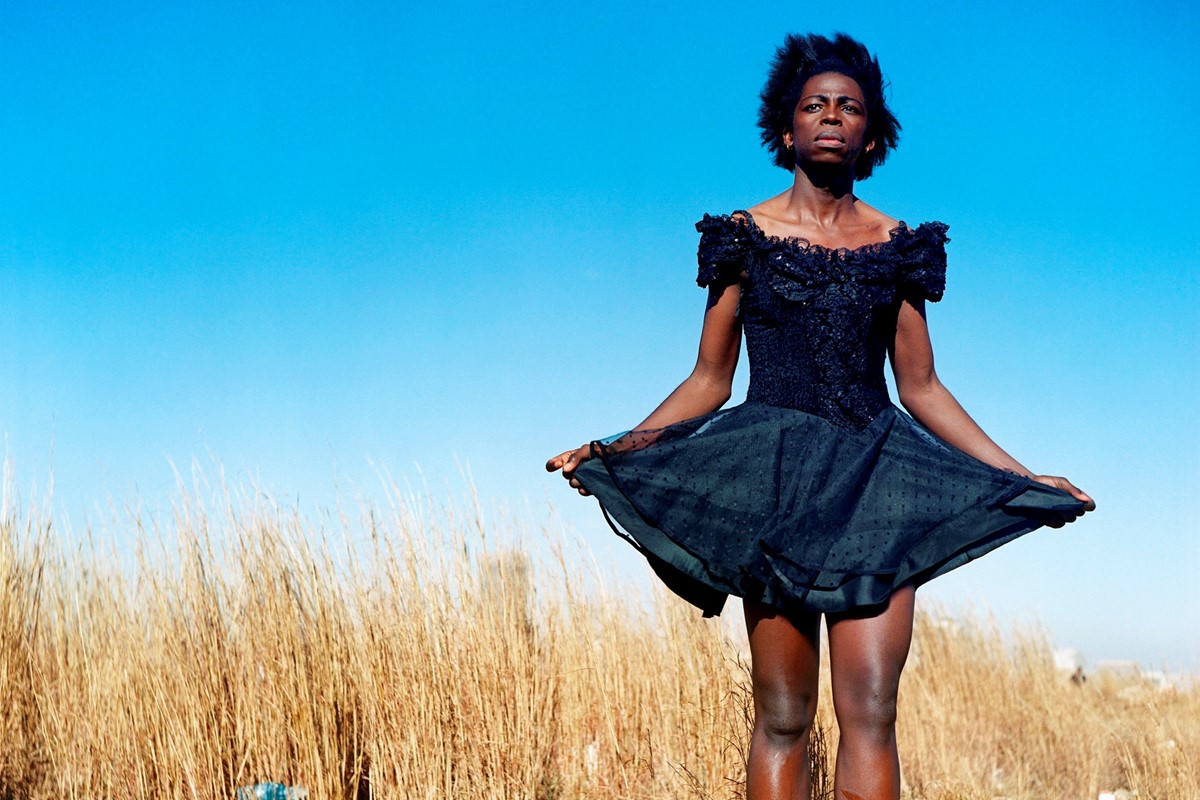“Brave Beauties” series - Dimpho Tsotetsi, Parktown
2014 - Photography (Photography)
76,5 x 51 cm
Zanele Muholi
As a visual activist for the rights of Lesbian, gay, bisexual, transgender, queer and intersex (LBGTQI), Muholi’s photographs radically transgress the conventional perception of lesbian and transgender communities in South Africa. Members of the LBGTQI community who suffer from continuous attacks — “corrective” and “curative rapes”, physical and psychological assaults, and hate crimes — Muholi works from her own community to create strong and positive images of empowered individuals. As visual statements, her photographs seek to dignify the members of an often hidden, voiceless and marginalized community. The verticality and scale of the prints accentuate the resilience of the figures, confronting the viewers with their scrutinizing and empowered gaze. The photographs support and promote self-expression, pride and autonomy in the face of an oppressive social system to reshape and reclaim an authoritative black lesbian and transgender presence in the global landscape. Presenting the black and white photographs as first-person testimonies of homophobia, discrimination and violence of LBGTQI black women, the “Brave Beauties” series thus acts as a conscription to autonomy and a visual activation of equal recognition.
Zanele Muholi (b. Umlazi, Durban, 1972) currently lives and works in Johannesburg, South Africa. She co-founded the Forum for Empowerment of Women (FEW) in 2002, and in 2009 founded “Inkanyiso”, a forum for queer and visual activist media. With the intention of highlighting the hate crimes in South Africa, Muholi subverts the oppressive narrative of Black queer and trans through rewriting a visual history.
Colors:
Other related works, blended automatically

© » ANOTHER
Zanele Muholi
Zanele Muholi’s Potent Portrait of South Africa’s Queer Community | AnOther As their new exhibition opens in San Francisco, Zanele Muholi talks about their powerful photos of queer survivors of hate crimes, couples in everyday moments, and self-portraits referencing history February 02, 2024 Text Emily Steer Zanele Muholi creates potent portraits...

© » KADIST
Pascal Shirley
2006Gypsy shows an ambivalent scene, in which broken blinds and its unsmiling subject are balanced with the stilllife plentitude of watermelon slices and the beautifully lit nudity of the sitter...

© » KADIST
Pascal Shirley
2006Like many of Pascal Shirley’s photographs, Oakland Girls aestheticizes a dingy rooftop and a cloudy sky...

© » KADIST
Miljohn Ruperto
2013Miljohn Ruperto’s high-definition video Janus takes its name from the two-faced Roman god of duality and transitions, of beginnings and endings, gates and doorways...

© » KADIST
Hank Willis Thomas
2012Thomas’ lenticular text-based works require viewers to shift positions as they view them in order to fully absorb their content...

© » KADIST
Elad Lassry
2013In his composition, Chocolate Bars, Eggs, Milk, Lassry’s subjects are mirrored in their surroundings (both figuratively, through the chocolate colored backdrop and the brown frame; and literally, in the milky white, polished surface of the table), as the artist plays with color, shape, and the conventions of representational art both within and outside of the photographic tradition...

© » KADIST
Charwei Tsai
2008Charwai Tsai’s photograph documents her Hermit Crab Project installation upon the construction site of gallery Sora in Tokyo...

© » KADIST
Hank Willis Thomas
2012Bread and Roses takes its name from a phrase famously used on picket signs and immortalized by the poet James Oppenheim in 1911...

© » KADIST
Du Zhenjun
2010The Tower of Babel is an installation of large-format photographs that forces the audience to occupy a central position through its monumental scale...

© » KADIST
Miljohn Ruperto
2009Acting Exercise: Demon Possession is a video by Miljohn Ruperto that addresses notions of performativity, the self, and collective truth...

© » KADIST
Hank Willis Thomas
2012Like many of his other sculptural works, the source of I am the Greatest is actually a historical photograph of an identical button pin from the 1960s...

© » KADIST
Eleanor Antin
1973Comprised of fifty-one photographic postcards, Antin’s 100 Boots is an epic visual narrative in which 100 black rubber boots stand in for a fictional “hero” making a “trip” from California to New York City...

© » KADIST
Miljohn Ruperto
2009Miljohn Ruperto’s silent video work Appearance of Isabel Rosario Cooper is an archive of ghosts...

© » KADIST
Yoshua Okón
2009Canned Laughter was Okón’s response to an invitation from Ciudad Juárez , Mexico, where artists were asked to create works based on their experience of the city...

© » KADIST
Enrique Ramirez
In Un Hombre que Camina (A Man Walking) (2011-2014), the sense of rhythm and timing is overpowered by the colossal sense of timelessness of this peculiar place...

© » KADIST
Agnieszka Kurant
2018Agnieszka Kurant’s Placebo VIII brings together a series of imaginary pharmaceuticals invented within the fictional narratives of literature and film...

© » KADIST
Tina Modotti
1930The Italian photographer Tina Modotti is known for her documentation of the mural movement in Mexico...



